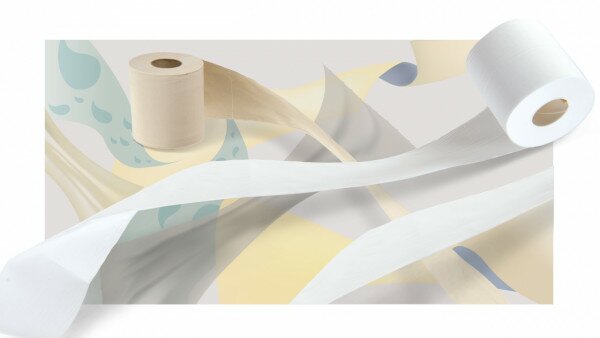Toilet rolls must rate one of the daily necessities that a household simply cannot live without, and coupled with their high consumption, hygiene and comfort issues, consumers will do well to choose for the optimal products both in value and quality. In a test on 25 models of toilet rolls, the Consumer Council has found wide variations among the samples in net weight, numbers of sheets, total length and area per row, and in addition, no direct correlation between the product weight and price. Almost half of the samples were found without such important product information given; and among the samples (13 models) provided with weight indication, more than half (8 models) were actually less than their declared value in weight. The Council stressed that to be accurately informed is a fundamental right of consumers; suppliers are responsible to ensure transparency in disclosure of full and truthful information for consumers' reference.
Included in the test were 21 models of 3-ply and 4 models of 4-ply, sold in 10 or 12 rolls packs and priced from $21.9 to $42, ranging on average from $2.2 to $4.2 per roll, a variation by almost a double. The overall performance of both the most expensive model and the cheapest model was rated equally with 3 points (on a scale of 5). In contrast, 2 models of medium priced (at $2.7 and $3.8 per roll) attained a higher rating of 4 points, showing that price and quality of toilet rolls are not always correlated, and that more rolls in a pack are not necessarily a bargain.
The test also measured the average number of sheets per roll, its total length and area, and again the results showed wide variations. On the number of sheets, it varied from 173 to 332 per roll, around 90% variation. Whereas the total length was measured from 20.2m to 41.7m, and the total area from 2.07m2 to 4.37m2, the variations were also over a double. Vast variations were also detected among the samples in net weight, i.e., stripped of their packaging and paper board core, with the lightest (85g) and the heaviest (196g) toilet rolls differing by as much as 111g or a double. Their prices when computed on a unit of per 100g net weight stood at $3.6 and $2 respectively, the difference was close to 80%. Significantly, in nearly all test items, the sample at $2 per 100g was rated equally as the sample at $3.6 per 100g, and an even more favorable overall performance rating. Although toilet rolls are not a costly item, little sums could add up formidably in the long run. The test has showed that some of the less expensive toilet rolls are actually better in quality than the more highly priced, consumers will do well to take this into reference in their choice.
Only about half (13 models) were marked with any product indication of the weight or total weight but 8 of them turned out to be less in net weight than what they claimed to be. Only 1 model was labeled with the number of sheets and the length and breadth of each sheet. In the absence of detailed product information disclosure, consumers would find it hard to carry out meaningful product comparison. Suppliers are urged to provide clear product labeling on the net weight, number of sheets and size measurements for increasing transparency of product information.
The samples were also put through a series of tests on their tensile strength (dry and when wet), and bursting strength. The combined test results indicated that the 3-ply samples were less superior in strength than the 4-ply toilet rolls. All 4 samples of the latter were rated 3 points or above. In contrast, among the 21 3-ply models, fewer than 30% (6 out of 21 models) could achieve a rating of 3 point and above. The rest were rated with a relatively weak strength of 2 to 2.5 points, among them were the 2 samples priced at $3.6 per 100g net weight.
In general, toilet rolls of strong strength may be in need of a longer disintegration time and at risk of blocking the drainage. But 2 samples of the 3-ply models found to be inadequate in strength (scored 2.5 points) also performed unsatisfactorily in the test on the ease of disintegration in water, with a low 2 or 1.5 points. Where absorbency is concerned, the majority of the toilet roll samples fared well, scoring 3.5 to 4 points, while one 4-ply model recorded a slower rate of absorbency, with a rating of 2.5 points, consumers should take note of this.
In the choice of toilet rolls, consumers are advised to pay heed to the following:
•Generally, prices of toilet rolls sold at drugstores or household goods shops are more stable, but the brands and models available at these outlets are also more limited;
•Supermarkets offer a bigger variety of choices and at various periods’ promotional sales for bulk purchase of 2 or 3 packs with lower average prices. Nonetheless, consumers should still shop around for comparison;
•Check – and compare – the packaging for product information on weight or the number of sheets per roll;
•Choose toilet rolls that come with a “heavier weight” hand feel and not easily dented as they are more tightly rolled; choose those with a bigger diameter of paper width and a smaller paper board core;
•Take note that toilet rolls with embossment are usually rolled more loosely;
•Don't waste precious paper, if a 3-ply toilet roll is sufficient for your purpose, it’s not necessary to opt for the 4-ply model;
•Store unused toilet rolls in a cool, dry place, well ventilated and clean, and avoid humid toilets for their storage.
The Consumer Council reserves all its right (including copyright) in respect of CHOICE magazine and Online CHOICE.



